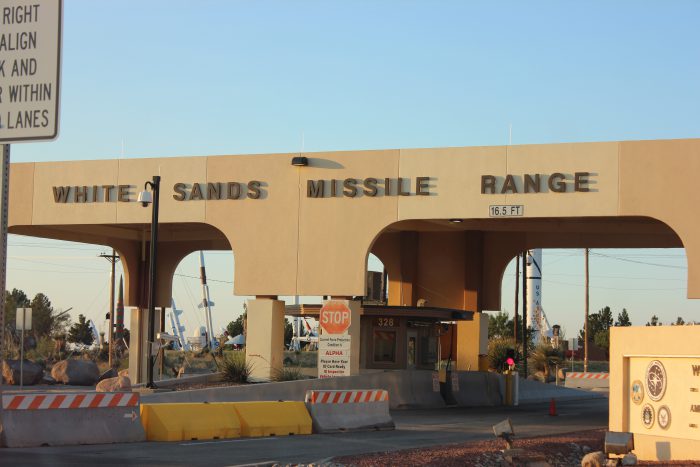The following article is a review of the 2017 Fredericksburg STEM Academy Senior class and their Red Bird #18 rocket. Most are excerpts from the articles that followed the program this year. A few are additions to the action that weren’t written about at the time, with added pictures and special sections on the WSMR launch and it’s results.
Completely new sections will be titled in RED instead of blue. Here are the high lights of Red Bird # 18 and the Fredericksburg STEM Academy 2017 Senior class.
August 31, Two weeks into the school year:
The school year was new and the Fredericksburg High School Engineering program had begun working toward new goals.
The program was off to a “Great start,” according to Engineering instructor, Andrew Matthes. “We received a NASA grant to continue testing and replace some older components for safety and increased fidelity in test data.”
A date of October 21, 2016 is set for Test Stand operations to start. A Test Stand task list and working groups have been established by the Senior group.
New to the program this year is a Senior out of class work schedule. Students signed a contract requiring them to commit to a set amount of overtime/after class work time in order to meet all deadlines and complete their rocket/project for the year. The group is currently establishing a working schedule in order to implement these hours. As for the actual rocket, the class is currently studying the rocket history portion of the curriculum.
This year the senior class has eighteen.
*************
October 11, the seventh week of school:
Seniors are alternating between rocket history and work on the Test Stand and Test Bed. They are currently in a break from the history but will rejoin it in a couple of weeks. Mean while they have conducted successful CDR’s (critical design review) for Test Stand that generated positive and developmental feedback. They have also had success updating the Test Bed. Wiring and programming issues have been corrected, they were able to create a new tank system which will increase safety in the fill and weigh of Nitrous operating systems, as well as succeeding in making the Test Bed more frictionless. Their senior rocket is still in the works as they continue in the design development of the vehicle.
New this year, the seniors created rocket history children’s books. Students will be doing recordings of themselves reading the books, and both the books and the audios will be sent to the Fredericksburg Elementary School where students there will be able to read the books and hear the high school authors read the books to them.
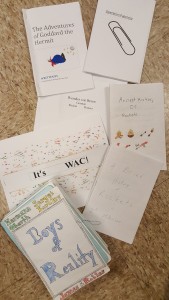
According to Mr. Matthes, “Their rocket history children’s books were awesome!”
On November 7 & 8, the senior group has a chance to go to the NASA Johnson Space Center, for flight profile reviews, grant updates, and a possible preliminary design review. Three students will go for sure, and those will be named at a later date.
Seniors, here is your challenge for the month, according to Mr Matthes, “If you complete the analysis of historic test data from the Test Stand then you will all be eligible to attend this trip. He would like to see that happen and take you all. Can you meet the challenge? Next month’s edition of this article series will publish the answer to this challenge. Now is your chance to show your readers and Mr. Matthes that you can meet the challenge.
************************
November 18, Covering October 1 – November 18:
The whole senior group made a trip to NASA Johnson Space Center on Monday and Tuesday, November 7 and 8. Only two were unable to attend, one due to family complications and the other was attending State Marching Contest on Monday with the FHS Band but joined the group later.
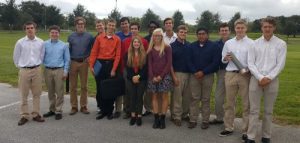
On Monday they collectively made a Grant Presentation to NASA. Mr. Matthes reports that, “they did wonderfully.”

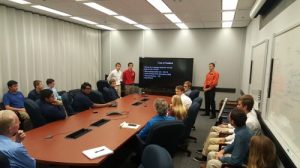
On Tuesday, Ian Kendrick, Sterling Weaterford, Nathan Bain and David Becker presented a Flight Readiness Profile. “NASA was impressed with Test Stand updates and the focus on analysis and improved data acquisition,” according to Mr. Matthes.
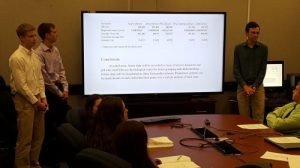
They also toured Johnson Space Center.
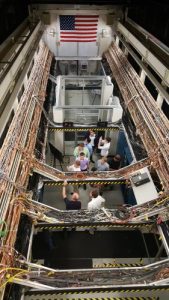

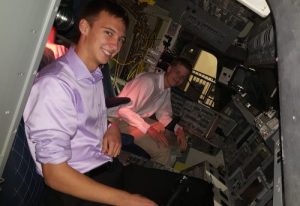
Students had time for fun while in Houston as well. On Monday, after dinner, students spent time at Kemah Boardwalk. Interestingly the “Crane Game” was the entertainment of the evening, pitting them against each other to see who could pluck the most stuffed animals. Reportedly, Ricky Robles was the winner.
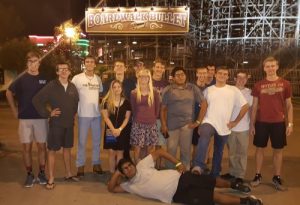
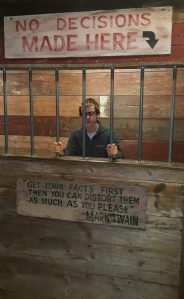
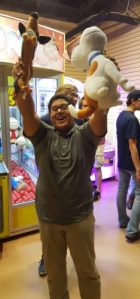
Those not involved in Tuesday’s presentation went to Space Center Houston where a good time was had by all.


The STEM Academy would like to extend many thanks to Mr. Logan Minshew, FHS Counselor and CTE coordinator. He took the time to attend this field trip and drive the group.
In other senior news, even though there is still quite a bit more to be done on Test Stand, they have made good strides and are progressing forward diligently. They are back at work with rocket design as well.
************************
December 21, Covering November 19 – December 21:
Seniors have been very busy, and experienced both successes and set backs on their projects recently. Testing on fuels is expected to begin in January as they are nearly complete with updates on Test Stand.
After manufacturing pieces for their Small Motor Test Stand out of 2024 aluminum, they discovered that this metal type cannot be welded. This resulted in having to procure another high strength aerospace aluminum which is conducive to welding. Once they find this they will have to begin again on the manufacturing of the fuel grain containment system.
“These were very important lessons learned for all, them and me,” stated Mr. Matthes.
Preliminary Design Reviews were conducted on their Goddard level rocket, last week. Due to the set backs on Test Stand, previously discussed, the group lost time they should have had to work on their rocket design and therefore have a bit of ground to make up there in order to have those completed by January’s end.
*****************
February 24, Covering Jan. 9 – Feb. 21:
The seniors conducted their first hot fire test on Friday, February 17, while Dr. Evans from the Space Propulsion Group was in attendance. They accomplished a 10 second burn of Low Density Polyethylene (LDPE).
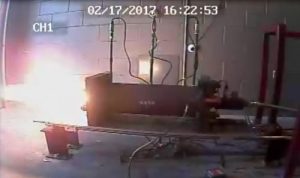 A still photo from the burn test.
A still photo from the burn test.
According to Mr. Matthes, ” The test was extremely successful with outstanding data acquisition that showed the motor preformed nominally, according to expected design parameters. This was very exciting to have such a good, clean burn, good data, and fitting expected performance.”
Heartland Enterprises and SRM Manufacturing created a newly designed injector plate. This allowed the class to keep their Friday deadline. In spite of the piece needing to be manufactured quickly for the project, these companies came through and the product was, “beautifully machined and performed with 10% of expectation regarding oxidizer mass flow rate,” stated Mr. Matthes.
On January 27, the Fredericsburg Middle School 7th grade GT(Gifted and Talented) group presented their payload for the Redbird #18 Rocket to the senior STEM class. It consisted of a group of sensors to measure UV Light, methane, acceleratometer, and barometric pressure.

 The 7th grade GT class presentation.
The 7th grade GT class presentation.
New this school year, Mr. Matthes started requiring after school and extra curricular hour work on senior projects. When asked how this senior group was doing with this on their project, here is what he had to say about the group.
“There have been a solid group of students who have been putting time in during study halls and some others who have been able to commit extended numbers of hours outside of school time to keep things moving forward. These senior students have worked phenomenally. They bit off a lot to accomplish this year and are on target to meet all of their expectations. It is quite remarkable having the opportunity and privilege to work with them. A substitute recently commented that during my absence, walking into the classroom after the passing period between classes was like walking into a full-fledged workforce environment where students were all fully engaged, scheduling, designing, problem solving, and just plain working without any instruction to do so. I believe the skills these students have honed over the last 4 years through this program and all their other coursework has created a ‘product’ that any college, industry, and organization would wish to recruit.”
Keep up the great work, seniors, what an amazing and glowing endorsement.
If you follow this program and like to view the launches, Rockets 2017 will be held at the Stewart Ranch in Willow City, Texas on the weekend of May 18-21, 2017. This testing site is open to the public. Please watch the SystemsGo website and this blog for upcoming information on the event. The FHS junior group will be testing their rockets on Thursday, May 18, 2017. The senior group is tentatively scheduled to launch their Goddard level rocket at White Sands Missile Range (WSMR) in New Mexico the week of June 26-30. There are also launches in Houston for schools in that area the weekend of May 12-14, 2017. New for this year the Hobbs, New Mexico group of schools will launch 1/1 rockets in Jal, New Mexico on April 27, 2017, this site will also be open to public viewing.
The STEM Academy group was encouraged to attend the movie, “Hidden Figures” on Friday, February 10th at Fritztown Cinema. About 35 students from the program attended.
************************
March 31, Covering February 22 – March 31:
The seniors have approximately 60 days as Red Bird #18 is scheduled for completion two weeks before school ends to allow for preliminary systems tests.
March began with more fuel grain tests at Test Stand. Two tests were completed in the first week alone, consisting of many hours of work to accomplish each. A temperature sensor indicated a high enough value in order to cause a programmed shut down on the first test that week. After investigation, it was found that a ‘electrical noise’ caused an anomaly which gave the sensor its reading, and that it was in fact not outside normal operating parameters. The actual test did not experience any temperature concerns.
The same fuel grain was able to be used again in a 20 second burn, which allowed students to achieve a cumulative 40 second burn on one fuel grain. The shut down was disabled for the second burn, allowing the data to still record the temperatures caused by the ‘electrical noise’, but not to stop the burn test and it was a full success without any further exceptions.
Mr. Matthes was very pleased with these burns and stated , “All data was processed and showed again the test stand was producing verifiable data similar to theoretical expectations.”
Students began another round of testing this week. Six new fuel grains will be tested accounting for three tests each of two different fuel types students have been working on. The hope is that they will cycle through smoothly due to the fuel grains being prepped prior to testing.
 Here Hannah Boubel is working with graphite in order to make ablative, which is a sacrificial material in the pre and post combustion chamber so the burn does not penetrate the liner and steel test cell.
Here Hannah Boubel is working with graphite in order to make ablative, which is a sacrificial material in the pre and post combustion chamber so the burn does not penetrate the liner and steel test cell.
 In this photo, Sterling Weatherford is preparing a fuel grain for installation in to the test cell.
In this photo, Sterling Weatherford is preparing a fuel grain for installation in to the test cell.
Along with test stand work, the students have been hard at work on Rebird 18, their Goddard level rocket slated to launch at White Sands Missile Range on June 27th. Students have already contracted with Heartland Enterprises and SRM Manufacturing for fabrications and parts have been supplied to them.
At this point in the process students are learning true cause and effect, and just how it can affect their outcomes. The entire success of the vehicle from this point forward is contingent on the group not only working as a team as a whole, but also for each individual team to stay on top of their work and outcome. Many of the components are dependent on the progress of the others. Delays on one team’s element directly affects the next team creating delays down the line and strained time schedules. Individual testing is conducted on each piece as it is finished. Full up integration and testing of any systems that allow for ground based testing is scheduled for two weeks from the end of school when the rocket is due to be complete.
“They are well on their way to a successful vehicle. The seniors will not have the luxury of adopting senioritis as there is still significant and mutually dependent work to be accomplished,” Mr. Matthes reported. “These next 60 days will be a true test of their team work, peer loyalty and persistence. ”
As the end of the school year approaches, these students are becoming more and more adept in their learning and knowledge as young and capable engineers. Their end of year rockets will be a testament to that learning, time and ability.
According to Mr. Matthes, “Students are becoming ‘plagued’ with knowledge and experience: the more they know and become aware of, the more they have to take into consideration and the more challenging the process becomes. However, it also makes for conditions more aligned with success. Additionally, if we consider these students products of FHS and the FHS Engineering, then they should be welcomed by a market hungry for what they have to offer.”
The senior group is tentatively scheduled to launch their Goddard level rocket at White Sands Missile Range (WSMR) in New Mexico the week of June 26-30. The current schedule (as of March 31) for that event is as follows:
Sunday, Jun 25th Travel Day
Monday, Jun 26th T-1 and Site Set up/Rocket Prep at WC-50
Tuesday, Jun 27th Launch Day One (Three Rockets – Fredericksburg, Union Grove, Alamo Heights)
Wednesday, Jun 28th Launch Day Two (Three Rockets – Anahuac, Booker T. #1, Booker T. #2)
Thursday, Jun 29th Contingency Day
Friday, Jun 30th Travel Day
***********************
May 2, Covering April 1 – April 30:
While the seniors are down to less than 3 weeks as Red Bird #18 is scheduled for completion two weeks before school ends to allow for preliminary systems tests. Due to delays in manufacturing, testing will have to occur in the process of construction as components come in. Final testing will be the week of June 19th prior to their test at WSMR the following week. It is slated to launch at White Sands Missile Range on June 27th.
During April the seniors tested Low Density polyethylene (LDPE) three times on Test Stand. Data on all tests was consistent and exemplary. Currently the injector plate is being drilled again to increase the oxidizer flow rate to the correct value to provide for complete combustion. Due to this testing is on hold. Lately they have been experimenting with different ablative arrangements. The ablative has burned through slightly but not enough to damage the test cell.
Below is an actual video of an engine burn test. This one of the first video’s with HD video quality and audio. The regularly captured video does not have audio embedded. This is good for them too as they do these tests for NASA and this gives them something more to show of their work.
https://goo.gl/photos/78HwtXxx8rytjxSV7
Mr. Matthes had this to say about this particular burn, “It looks pretty good but we’re only getting about 1/3 of the oxidizer we should be getting so it is fuel rich. It will not be as orange when we get the oxidizer flow rate correct. The hope is that it is a really clean plume with mach diamonds in the plume.”
The senior’s “junior Test Stand” nick named “Baby Bird” is almost complete. They hope to conduct their first ever test on this new Test Stand possibly late this week. This Test Stand was created by the seniors starting last year during junior studies to test a fuel grain system designed and developed by them to interface with the hyportek injector and tank. They hope to have 3 successful tests on this Test Stand. If they achieve this, then they get to fly this new system at Willow City in last year’s rocket. At this point, they are getting fuel grains prepped. Pictured below, are nozzles created for Baby Bird.

Red Bird #18 still currently does not resemble a rocket, but they are making steady progress. The nozzle has been manufactured, seen here 


and the nose cone mold is also back, seen here. 
Machining could only be created to within 8 inches of the tip, therefore they created the tip with 3D printing and epoxied it to the nose cone and are preparing it for fiberglass.
Other needed materials are in and have been sent out to Heartland Enterprises for machining. Currently, Mr. Matthes says that the biggest test coming up will be next week when they pressure test the oxidizer tank.
*************
May 15th, Covering Baby Bird:
Hopes were that three successful tests on the new “junior test stand” nick named “Baby Bird” over the past weekend would result in the opportunity for the seniors in the Fredericksburg STEM Academy to fly a new Hybrid student developed rocket at Willow City. The purpose of this Test Stand, as highlighted in the last update, was to test a fuel grain system designed and developed by the seniors to interface with the hyportek injector and tank.
Saturday evening, May 6, they conducted their first ever test of the Baby Bird. Unfortunately according to Mr. Matthes, “the containment system experienced thermal damage which tables Baby Bird for this year”


Baby Bird may not send a rocket out this year, but she is not at her end. According to Mr. Matthes, “we will continue with the testing of it…The Baby Bird still is important research that can be utilized by SystemsGo to increase the rigor of the Oberth level of the program to include motor design.”
Mr. Matthes congratulates the class on their hard work and efforts, “Burn looks great though… well designed propulsion. Very curious to see the data which looked promising at a glance. Great job FHS Engineering Class of 2017!”
****************
May 16, Willow City Launch Week, Two Weeks Before Graduation:
Even though the seniors’ “Baby Bird” Test Stand rocket will not fly at Willow City this year, they are still hard at work and progressing well on Red Bird #18 for WSMR in June. The tank has been tested successfully and the vehicles stability has been verified by NASA. This allowed for the fins to be cut so that they can be beveled for aerodynamic purposes, and then welded to the vehicle. The door panels on the forward skirt and aft skirt have been cut, and will be welded to the tank this week.
Four students accumulated 12 hours of work over the weekend fiberglassing the nose cone. According to Mr. Matthes, “Things are coming together very well, but there is still a lot to do.”
*************************
May 31, Graduation Week:
Seniors are in decent shape on Red Bird #18. The vehicle is undergoing final welding at SRM Manufacturing. Nosecone is wrapping up well. The current set back is the fuel grain. After conducting extensive testing to get the correct percentage of the two constituents and creating multiple samples at those percentages, when the students mixed their full volume of HTPB (rubber) fuel, it set too quickly and they were unable to pour it. Students created more samples yesterday of the same percentages but at different temperatures trying to manipulate the cure time. They are receiving a borrowed supply of one chemical from Alamo Heights High School to complete the fuel grain on a second attempt.
The seniors will also be presenting tomorrow, Thursday, June 1 at FISD’s Central Office board room beginning at 12:15. They will giving a status update on the development of the Red Bird #18 rocket that is scheduled to launch at White Sands Missile Range in late June, as well as covering the progress and testing on the hybrid rocket motor Test Stand.
All are welcome to observe both presentations.
Subsequent updates will continue to follow the Senior/Graduates and the progress of the Red Bird #18 rocket through June and until after launch at WSMR in late June.
******************
June 21, 1 Week Until Launch at WSMR:
Red Bird #18 is scheduled for testing at White Sands Missile Range(WSMR) next Wednesday, June 28. This marks the last big event for Rockets 2017 and the Fredericksburg STEM Academy for this season.
These are the Goddard level rockets, which are the culmination of all the skills the students have learned throughout their years in the STEM program. This marks the final senior project for those schools that participate in this level of the SystemsGo program.
According to team member, Sterling Weatherford, “We are finishing up our rocket production, with integration and final testing before we head off to White Sands.”
Mr. Matthes reports that welding on the vehicle is complete and it is together. Below is a pictures of the class with the vehicle at SRM Manufacturing, one of the outsource businesses they contracted for help with welding. In order left to right the students are Jesse Cedillo, Colby Marthaler, Ricky Robles, Langston James, Nathan Bain, Chase Ottmers, Hannah Boubel, Joseph Sanchez, and Sterling Weatherford.

Other members of the group not pictured here are David Becker, Drew McDonald, Matthew Dulaney, Corbin Styles, Josh Treibs, Payton Carroll, Cody Pruett, Levi Crawford, and Ian Kendrick.
The students report that they are putting finishing touches on the nosecone, including sanding and a gel coat to create a smooth finished surface. They will be installing the complete motor system in to the rocket today, Wednesday, June 21.
They had been working on integrating the recovery, propulsion and fuel grain systems into the vehicle. All parts have been fit tested for the integration. Recovery, avionics, and the payload have since been successfully installed.
They are finishing the assembly of the fuel grain including an ablative that the students have chosen to add to the post combustion portion, after which they can install the fuel grain and the rest of the propulsion system into the rocket.
 Here one of the students shows the injection valve and injector bell arrangement.
Here one of the students shows the injection valve and injector bell arrangement.
Here is a picture of Drew McDonald, Ricky Robles, and Jesse Cedillo earlier when they were mixing fuel for the second attempt at the fuel grain.

Their final actions will be to test the black powder charges for the recovery system and then they will be ready to move the rocket to WSMR for their full vehicle launch testing.
“We are extremely excited to test our rocket at the upcoming White Sands Missile Range launches,” Sterling reported.
Monday evening they met to discuss travel plans and trip expectations.
Launches are scheduled for June 28 through June 30. The group will travel out to WSMR on Monday, June 26, and back home again on Saturday, July 1.
There are 5 schools scheduled to launch 6 rockets. These schools include:
- Alamo Heights (1)
- Anahuac (1)
- Booker T. Washington ( 2)
- Fredericksburg (1)
- Union Grove (1)
This year is unique in that the Army has some classified tests scheduled that will slightly overlap SystemsGo’s air space on both June 28th and June 30th. This could delay start on Wednesday, and it has already been set to 0700. The hope is that all launches will be complete by Thursday afternoon so that Friday will not be needed since another high priority group will be needing that day as a back up day as well. SystemsGo will travel home Friday if this can be accomplished instead of one day later on Saturday.
The current launch schedule (as of June 21) is as follows:
- Monday, Jun 25th Travel Day
- Tuesday, Jun 26th T-1 and Site Set up/Rocket Prep at WC-50
- Wednesday, Jun 27th Launch Day One (Three Rockets – Fredericksburg, Union Grove, Alamo Heights)
- Thursday, Jun 28th Launch Day Two (Three Rockets – Anahuac, Booker T. #1, Booker T. #2)
- Friday, Jun 29th Contingency Day/Travel Day
- Saturday, Jun 30th Travel Day
The senior group presented their project and made reports on June 1st as their final exam for the year.
Today is 5 days out until the Red Bird #18 group leaves for WSMR. Watch this blog next week for information and reports on this and all the schools’ launches at White Sands Missile Range.
 This was presented to the Red Bird #18 group after their June 1 end of year presentation. The sentiment still holds as we congratulate this group of graduates on their accomplishments and the achievement of finishing their rocket. Good luck at WSMR!
This was presented to the Red Bird #18 group after their June 1 end of year presentation. The sentiment still holds as we congratulate this group of graduates on their accomplishments and the achievement of finishing their rocket. Good luck at WSMR!
*************************
June 25, Sunday, Getting Ready for WSMR:
The Red Bird #18 Rocket team met at SRM Manufacturing to pick up and load their vehicle into an enclosed trailer provided by Mr. Banfield, Nathan Baine’s step dad. He transported the rocket to WSMR for the team.



Finishing touches by Luke Morin of SRM Manufacturing.




Team photo with the vehicle before loading.
 It takes the whole team to move the rocket and load it into the waiting trailer.
It takes the whole team to move the rocket and load it into the waiting trailer.




Final photos with the Red Bird #18 Team, instructor, Mr. Matthes, and Luke Morin of SRM.

Red Bird #18 Rocket, ready for the trip to White Sands Missile Range in New Mexico. The bundle in the back corner is the nosecone.
The bundle in the back corner is the nosecone.
After loading, the team and parents reconvened at FHS STEM Academy to load all needed parts and equipment for travel and final prep of the rocket in New Mexico.
***************************
June 26, Monday, Leaving for WSMR:
The Red Bird #18 team left Fredericksburg at 8:00 a.m. this morning headed to White Sands Missile Range (WSMR) in New Mexico, followed by the SystemsGo team which left Fredericksburg at 9:00 a.m. .
Tomorrow is an informational and set up day. SystemsGo personnel and all students, teachers, and parents from the schools head out at 6:30 a.m. for T-1 briefing and a short presentation by each school on their vehicle and it’s expectations. Afterwards SystemsGo, students and necessary personnel go to West Center 50 launch site to set up and prep vehicles. Parents will be dismissed at that time to find their own entertainment for the day.
Wednesday is the first launch day and at this point, it is slated to be an early morning. Fredericksburg STEM Academy is first up to launch for the day and the current schedule has them testing at 6:00 a.m. The hope is to test 3 vehicles by 10:00 a.m, including Union Grove and Alamo Heights.
*****************************
June 27, Tuesday, T-1 Briefing and Launch Site Setup
SystemsGo and the participating schools had a productive first day at White Sands Missile Range (WSMR) today. They started the day with the T-1 Briefing, which included several presentations by WSMR staff on all they do to make these launches possible. It was an educational and informative session.
WSMR personnel made introductions so all involved would know who they are and who to contact for help from the base. At the end, Scott Netherland introduced the SystemsGo team and specified their roles with the organization. We finished around 11:00 and headed out to West Center 50 launch site(WC50).
All equipment and rockets had to be set up and completed to meet the Wednesday testing schedule. Everything was eventually finished by 8:00 p.m. It was a very productive day albeit a little long and quite hot.
Tomorrow will be a super early morning for all of us. Teams launching and SystemsGo personnel will be headed out to WC50 at 2:30 a.m. And those going to watch the launches from Mission Control will be heading out at 3:30 a.m. to meet our rep at the main gate by 4:30 a.m.
6:00 a.m. Fredericksburg High School
7:30 a.m. Union Grove High School
9:00 a.m. Alamo Heights High School
If it is a perfect day and all goes well with no exceptions with each launch, then the tests should be complete by 12:00 p.m. Realistically, this is a very tight launch sequence with little to no room for errors. If we do not get all three launches tomorrow, then there will be four launches on Thursday. Friday has now been canceled as WSMR has other high priority missions that need the range, so there is no longer a back up day, and that will also allow everyone to head home on Friday instead of Saturday.
****************************
June 28, Wednesday, Launch Day at WSMR:
Today was an extremely early morning for the SystemsGo team and program participants, Fredericksburg High School, Union Grove High School and Alamo Heights High School. They were all up at 2:00 this morning headed to the range, here at WSMR to test. They had success in that they met all three T times for the day with only 20 minute variances.
Fredericksburg STEM Academy was first to test, leaving the rail at 6:20 a.m. It started off well with what looked to be a beautiful flight, but it was short-lived. It quickly lost thrust climbing to only just over 300′ before nosing over, re-firing, and plowing into and along the range. Luckily, the nose cone chute deployed shortly before impact, taking it away from the harsh landing. WSMR optics reported the vehicle only reached a speed of just under 100 ft/second, but still managed to travel 920′ down range.
This was not quite the flight students had hoped for, but for today they hold the flight record for these three launches. Even though, the schools are not competing against each other but awarded only on their own accomplishments, students all want to have the most successful flight of the season.
Post Mission Analysis by Mr. Matthes of what he observed of the Red Bird #18 Flight and it’s Post Mission testing capabilities:
“It was evident to me prior to leaving the rail that it was not achieving the desired thrust as its acceleration was poor and not for matching the flight model. The plume was initially clean but it was also visible that there was incomplete combustion with a very faint trail. It was consistently lacking thrust. Once it went past horizontal the liquid oxidizer rolled towards the nosecone leaving gas entering the injection system and the plume went black…the re-firing is suspected that as both the vehicle and liquid were falling at the same rate than liquid again was in contact with the aft injection system and propulsion resumed. Some believe that the injection valve which was powered based on an onboard battery pack had an issue. The pack was initiated by 12V pad power which operated a latching switch. I don’t see this the most likely cause of it going black and then thrusting again unless there was a fluke connection between the batteries), and plowing into and along the range. Luckily, the nose cone shoot deployed shortly before impact, taking it away from the harsh landing(The FHS Payload was aborted due to a programming error that prevented the recording of data…the payload was therefore saved for future efforts. FMS payload was therefore saved from a catastrophic landing.
FHS was the only vehicle that did not suffer any mechanical failure. The aft section is in good condition and I have offered students to test the injection system with their remaining time this summer as we had a delivery of oxidizer just over a week ago. Because it is fully intact from valve to nozzle they could technically perform a short duration hot fire but I believe the bolts holding the bearings the sled are not rated for the theoretical 2000lb thrust. I would therefore recommend them conduct a cold flow test. This could be done with the current 1” Moog valve in the test stand testing the injector plate design and also with the rocket integrated valve. Students are circumspect that it was the valve that caused the poor ṁ issue. However in our testing at the test stand the ṁ calculations that lead to the injector plate design lead to an ṁ that was under 40% of expected. So both are suspect at this time. Technically the nosecone deployment did “test” the parachute that Chris had specified but unfortunately I can say with reasonable certainty that we did not achieve the 15-20psf with only a 30lb nosecone attached. However, we still have it to test again.”
******************
With Red Bird #18 Behind Them, Here is What They Have Planned Next:
The Red Bird #18 team spent Thursday June 29th, exploring and sight seeing in Alamogordo. New Mexico Museum of Air and Space, and the White Sands National Monument as well as a movie were on the schedule of down time events. Here the group is seen hanging out on the dunes after some sledding at the monument.

Pictured here are Ian Kendrick, Nathan Bain, Langston James, Chase Ottmers, Payton Carroll, David Becker, Jesse Cedillo, Sterling Weatherford, Matthew Dulaney, Hannah Boubel, Joseph Sanchez, Joshua Treibs, Colby Marthaler, and lounging on the sand in front, Ricardo Robles. Not pictured are Levi Crawford, Christian McDonald, and Corbin Styles.
This year’s group is a tight-knit team of friends, according to Payton Carroll, they were getting together again after WSMR for one last outing as a group. Each of these students has been impacted by the program and the commradery of being part of this team. Their future plans take them to different places, but all have a clear direction with a very promising outcome.
Here is a list of each and their upcoming plans:
- Nathan Bain–Embry Riddle–Aerospace Engineering–R & D for Aircraft
- David Becker–University of Utah–Computer Science–Software Development
- Hannah Boubel–USMA–BioMedical Engineering–Prosthetic Development
- Payton Carroll–Texas A&M San Antonio–Medical Engineering–
- Jesse Dedillo–Angelo State–Computer Science–Software Development
- Levi Crawford–US Marines–Sniper Training–
- Matthew Dulaney–UT Austin–Chemical Engineering–Pharmaceutical Research
- Langston James–Texas A&M–Mechanical Engineering–Outdoor Industry
- Ian Kendrick–Austin College–Political Science Psychology–Law
- Colby Marthaler–Texas State–Archeology/Anthropology–Archeologist
- Christian McDonald–Texas A&M–Architecture Urban Planning
- Chase Ottmers–Texas A&M–Chemical Engineering–Environment
- Cody Pruett–Unable to obtain information for this individual
- Ricardo Robles–Baylor–Political Science Law–Law
- Joseph Sanchez–Harvard–Mechanical Engineering–Aerospace
- Corbin Styles–UTSA–Engineering Computer Science–undecided
- Joshua Treibs–Recently joined the Fredericksburg Vol. Fire Dept., working on getting his EMT certification, plans to go to Paramedic school through UT Health, Emergency Health Sciences
- Sterling Weatherford–Arizona State University–Aerospace Engineering–US Army Aviator
****************
Author’s End of Year Synopsis:
Success this year was a very relative thing. By the old original standard, the “Goddard Diamond Award”, a vehicle was only required to get off the rail under propulsion/ignition. This year, a new standard of awards was outlined at WSMR including the following:
New Awards standards are:
- Newton Award –off rail 25,000’
- Einstein Award –off rail 25,000-50,000’
- Van Braun Award – off rail 30,000-75,000’
- Kepler Award-off rail 75,000-100,000’
Out of the 6 that were tested, only four, Fredericksburg, Anahuac, Alamo Heights, and the second of the Booker T rockets, Golden Eagle 6, left the rail in tact and under their own propulsion. This qualifies them for the old Goddard Diamond Award and the new Newton Award as outlined above.
Booker T’s Golden Eagle 5 left the rail without its engine, purely flying on expelled Nitrous. The engine and aft skirt stayed hanging askew on the rail. Therefore this could not really be considered as under propulsion/ignition and does not qualify under that standard. Union Grove, sheared off its engine at lift off sending it flying across the pad, which caused the vehicle to slide back down the rail and come to rest on the pad where it burned out, also a disqualification for the award.
That being said, there is still a degree of success achieved in actually building a launch ready rocket, that is accepted to test at WSMR, and bringing it there to test.
Therefore, no team this run was terribly successful in terms of reaching high altitudes. Although for this year, Anahuac achieved the highest altitude and for them this is only the second time off the rail and a much higher altitude than last year’s flight.
For Booker T, this may have been only the second time they have had a vehicle leave the rail and be fully intact. I know they left the rail in 2015 for a very short flight. I do not have information on years prior to that for them.
SystemsGo is extremely proud of all the schools that successfully built a rocket to be tested out at WSMR this year. As they recognize and appreciate the diligence and dedication shown by students and teachers throughout this process, they are striving to hold the schools to a better standard of workmanship and success from here on out for the Goddard level launches. It was for this purpose SystemsGo reiterated these new standards for awards this year at the T-1 briefing, that will have to be adhered to for all future WSMR launches. All rockets must also have a payload and recovery system to qualify to fly and receive an award.
Under these standards, Anahuac would be the most successful launch this season, and would achieve an award, as shown above. Fredericksburg, Alamo Heights, and Booker T’s Golden Eagle 6 also qualified for this same category.
Now that all that has been said, might I quote Mr. Matthes again, “FHS was the ONLY vehicle that did not suffer any mechanical failure.” So perhaps, as I said before, there are different degrees of success this year and they may vary widely on your perspective. Congratulations to the 2017 Fredericksburg STEM Academy on a job well done. You may well have learned more from your short flight, than if you had achieved your desired 100,000′, because where there is no perceived failure, there is also no desire to problem solve and look for the greater success.
************************
This article is the final in a new series of monthly updates that followed the Fredericksburg Engineering/Rocket program this 2016/2017 school year. This school is a participant of the SystemsGo STEM program. This series of articles is intended to support and encourage students in the program as they share their working status and accomplishments throughout the year in the program. These publications are available for tags and re-posting.
www.systemsgo.org as always is the place for more information on this program. Take the time to get your school involved, the future of your students will be greatly benefited. SystemsGo is a Texas-based STEM curriculum program.
#Rockets2017 #SystemsGo #FredricksburgSTEMAcademy #Launcher01 #ItISRocketScience #SystemsGoNews #Highschoolrockets
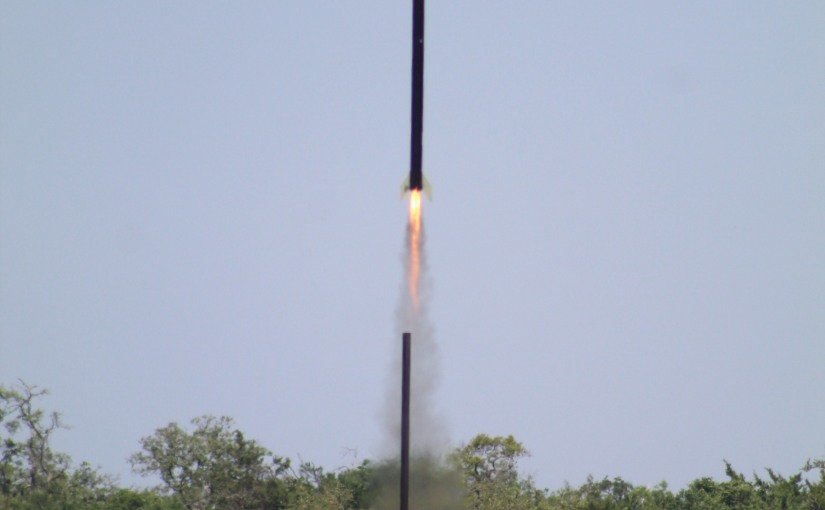



















 A still photo from the burn test.
A still photo from the burn test.
 The 7th grade GT class presentation.
The 7th grade GT class presentation. Here Hannah Boubel is working with graphite in order to make ablative, which is a sacrificial material in the pre and post combustion chamber so the burn does not penetrate the liner and steel test cell.
Here Hannah Boubel is working with graphite in order to make ablative, which is a sacrificial material in the pre and post combustion chamber so the burn does not penetrate the liner and steel test cell. In this photo, Sterling Weatherford is preparing a fuel grain for installation in to the test cell.
In this photo, Sterling Weatherford is preparing a fuel grain for installation in to the test cell.







 Here one of the students shows the injection valve and injector bell arrangement.
Here one of the students shows the injection valve and injector bell arrangement.
 This was presented to the Red Bird #18 group after their June 1 end of year presentation. The sentiment still holds as we congratulate this group of graduates on their accomplishments and the achievement of finishing their rocket. Good luck at WSMR!
This was presented to the Red Bird #18 group after their June 1 end of year presentation. The sentiment still holds as we congratulate this group of graduates on their accomplishments and the achievement of finishing their rocket. Good luck at WSMR!








 It takes the whole team to move the rocket and load it into the waiting trailer.
It takes the whole team to move the rocket and load it into the waiting trailer.






 The bundle in the back corner is the nosecone.
The bundle in the back corner is the nosecone.

